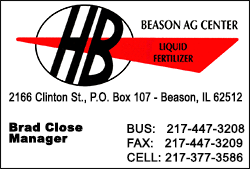_small.JPG)
Dr. Bill Becker of Agrosystems Management, Inc. explains how
he uses a "systems approach" to farming. Dr. Becker
was a guest lecturer during a field day at PrairiErth near
Atlanta in September. The event was hosted by Illinois
Stewardship Alliance.
Other topics of the morning
included Cover Crops, Value adding with diversity, as well
as research projects being conducted at University of
Illinois and Illinois State University
Photo by Curt Fox |
2014 Fall Farm Outlook:
What's bred in the ground
By Jan Youngquist
 Send a link to a friend
Send a link to a friend
[November 12, 2014]
LINCOLN - One morning early in
September, local farmers came together to hear some of the latest on
land stewardship and crop production. The Illinois Stewardship
Alliance hosted the in-the-field Sustainable Agriculture program at
PrairiErth Farm near Atlanta.
One of the guest lecturers was crop science researcher, Dr. Bill
Becker, better known as "the Crop Doctor." Dr. Becker is an
agricultural consultant based in central Illinois, but he does work
all over the county. Becker shared his method of evaluating a field
and some of the latest breakthrough measures in sustainable
agriculture.
|
|
 Becker implements a full system analysis approach. He looks at
each field, even its quirks, and uses biology, chemistry and
physical factors in his recommendations. He emphasizes no-till or
modified no-till. The combined measures consistently result in
healthier soil conditions that lead to lower crop input costs and
increase yields. Becker implements a full system analysis approach. He looks at
each field, even its quirks, and uses biology, chemistry and
physical factors in his recommendations. He emphasizes no-till or
modified no-till. The combined measures consistently result in
healthier soil conditions that lead to lower crop input costs and
increase yields.
Each type of plant has specific nutrient needs. Corn needs differ
from soybean. While elements like phosphorous, calcium and other
essential nutrients are plentiful in Illinois soils, they are often
inaccessible to the plant. In less than optimal soil conditions when
a plants roots are unable to take up the needed nutrients, or the
nutrients are locked up, the plant's health suffers giving
opportunity for insect or disease infections, and the general result
is lesser and lower quality product.
A pound of roots equates to a pound of grain.
The healthier the plant, the more able it will be able to withstand
uncontrollable environmental stresses -- wet soils, drought, wind,
cold; and biological stresses -- insects and disease. Also,
nutrients taken up by a plant may influence nutritional values in
products processed for human, livestock and pet foods consumption.
 Soil is a solution full of nutrients subject to change with the
environment throughout a season and over years. Dr. Becker uses soil
and plant tissue tests to macro-manage major and minor nutrients
that bring soils into balance for crop needs.
Becker says that farmers focus too much on the standard nitrogen,
phosphorous and potassium (NPK), and not enough on the other
thirteen essential elements that act as 'micronutrients' for healthy
plant tissue. While N and K make a corn stand; phosphorous, sulfur
and zinc are important too.
He uses soil tests to determine the amounts of nutrients already
present in the soil. Comparatives to plant tissue tests show what is
not being absorbed and what might be going on in a soil. The
nutrients might be present in a soil but not in an available form.
Chemical or biological changes can be induced in the soil to free up
nutrients.
Becker says that soil nutrients can significantly be brought closer
into balance in a three year period. Each year sees results leading
to greater sustainable lower costs and higher yields.
 Becker's full system blend of chemical, biological and physiological
measures includes adjusting fertilizer, which acts as a catalyst for
nutrient absorption; maintain or increase organic matter; reduce
compaction to improve soil structure, which allows a plant to
utilize important micronutrients; and one other big thing, control
nematodes that cause root damage.
Balancing nutrients in soil is a complex process that may be
achieved by chemical or biological/physical means.
Nutrients are influenced during a given season by natural forces,
such as drought can change the concentration of calcium (Ca). Ca
plays a complex and variable role in soil affecting structure and
other nutrient availability. Ca can be chemically freed up for
absorption or bound through introduction of other more or less
active elements. Ca forms a complex with magnesium, making the
magnesium unavailable, which is already low in Illinois soils. Other
elements that combine with magnesium are phosphorous, iron, copper
and manganese. A soil and plant tissue analysis comparative can
determine what is needed in the soil.
A biological additive has been found to aid plants in absorbing
phosphorous. Phosphorous is plentiful in Illinois soils, but the
form is as a contact element. Roots must come in contact with
phosphorous for it to be absorbed.
Mycorrihizal (my-core-rise'-zay) fungi attach to plant roots and the
fungus extends hyphae out, which then absorb the phosphorous. These
fungi are already present in Illinois soils, but the addition a
super variety of the fungi increases plant roots ability in
phosphorous uptake. Becker says, "The phosphorous uptake by the
hyphae is so good, that there is no need to use phosphorous
fertilizers after the soils are inoculated with the mycorrhizal
spores and good infections occur."
[to top of second column] |

Using the most current statistics for Illinois, in 2010 the average use of
phosphorous on corn and soybeans acres was 21.7 pounds per acre. Phosphorous at
$1.7525 per pound on 21.7 million acres cost Illinois farmers $825,234,730.
Spores are a bit pricey, Becker said, but a one-time inoculation of aggressive
mycorrhizal spores at five pounds per acre typically pays for itself in the
first year.
And, even better yet, add dry kelp meal at 10 pounds per acre. The fungi and
kelp work synergistically. The two increase soil aggregates improving soil
structure. With the use of shallow- or no-till practice, the fungi increase and
soil aggregates increase.
With these practices you will also gain the benefit of earthworm channeling and
casts which provide even greater soil structure, more potassium and phosphorous.
The benefits compound by the year.
Plant health is also challenged by soil nematodes. Becker said that nematodes in
the soil have increased since the use of Roundup began. He was very excited to
share a breakthrough in his research that came just this year. The use of
Redman's salt, (salt mined from Utah salt flats) at 20 pounds per acre decreases
nematodes. But it has now been proven that up 40 pounds per acre can be used
with greater results of eliminating nematodes and no harmful build up of salt in
the soil. Soil can go 100 parts per million.

Liquid chitin recently received an EPA label, has been shown effective in
control of nematodes. In 2008 a field of soybeans near Jacksonville increased
yields by nine bushels.
According to Becker, when analyzing a field, there are 1200 potential
relationships to examine. The most important factors related to yield are
related to organic matter.
Dr. Becker strongly supports using no-till or shallow-till (no more than two to
three-inches), cover crops and maintaining surface residue to enhance soil
health and protect it from erosion.
For more information you can contact Dr.
Bill Becker 'the Crop Dr.' or the Illinois Stewardship Alliance.
Agrosystems Management, Inc.
Dr. Bill Becker
1229 W. Edwards St.
Springfield, IL 62704
Cell: (217) 622-5322
Illinois Stewardship Alliance
230 Broadway Street
Suite 200
Springfield, IL 62701
Phone: 217-528-1563

|